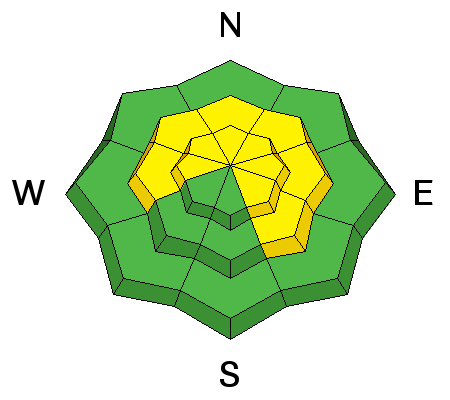25th Annual Black Diamond Fall Fundraising Party
Thursday, September 13; 6:00-10:00 PM; Black Diamond Parking Lot

25th Annual Black Diamond Fall Fundraising Party
Thursday, September 13; 6:00-10:00 PM; Black Diamond Parking Lot
| Advisory: Provo Area Mountains | Issued by Evelyn Lees for Tuesday - March 20, 2018 - 7:07am |
|---|
 |
special announcement
|
 |
current conditions It’s the Spring Equinox, with the day and night the same length. Skies are partly cloudy this morning and temperatures dropped into the low 20s at most mountain weather stations in the Provo area mountains. Winds have shifted to the southwest and are light – averaging 5 to 10 mph at the Provo mid elevations and 15 to 20 mph on the highest peaks to the north. Yesterday’s sun made quick work of the dry snow, and most slopes will be crusted this morning, softening later today. Upper elevation northerly facing slopes hold the last of the cold dry, powder. |
 |
recent activity No new observations from the Provo area mountains. To the north, in the Salt Lake area mountians: Both dry and wet loose sluffs occurred yesterday. One slide broke into old snow with avalanche mitigation work - on a NE facing slope at 10,200’. In addition, an intentional cornice drop pulled out a storm snow slab 200’ wide, 1 to 2 1/2 feet deep on a lower apron below cliffs. Photo below.
|
| type | aspect/elevation | characteristics |
|---|


|


|

LIKELIHOOD
 LIKELY
UNLIKELY
SIZE
 LARGE
SMALL
TREND
 INCREASING DANGER
SAME
DECREASING DANGER
|
|
description
With all the new snow this past week, with up to 2" of water it is still possible to trigger a deep avalanche breaking on a weak facet layer in the snowpack. While these deep slab avalanches are unpredictable and difficult to trigger, if you do, it will be very large and dangerous. Deep slab avalanches could be triggered by a person or a smaller slide - especially avoid steep, complex terrain with sharp break overs, rocks or cliffs and shallow snowpack areas, such as slopes that have already slid one or more times this year. |
| type | aspect/elevation | characteristics |
|---|


|


|

LIKELIHOOD
 LIKELY
UNLIKELY
SIZE
 LARGE
SMALL
TREND
 INCREASING DANGER
SAME
DECREASING DANGER
|
|
description
With today’s mix of mid to high level clouds, periods of sun and light winds, the snow on some slopes will heat up enough for wet loose sluffs, while other slopes will stay cool. Constantly evaluate the surface snow where you travel – if the snow becomes wet and sloppy or you’re easily triggering roller balls – it’s time to move to a cooler aspect or low angle terrain. Periods of high thin clouds can heat the snow on the shady slopes (commonly called green housing). Once wet sluffs get moving, they can entrain snow as they move down slope, piling snow up deeper than expected, especially in terrain traps like gullies and creek beds. Llong running wet sluffs are possible in the Provo area mountains due to the continuously steep terrain. Below: snow off a heating cliff band triggered wet loose sluffs. An uptrack that was safe in the cold early morning isn't once the day heats up. Mark White photo, Cardiac Ridge. |
 |
weather We’ll have warm temperatures for the first day of spring – reaching near 30 at 10,000’ and near 40 below 9000’. Skies will be partly cloudy, and the southwesterly winds should remain light all day, 5 to 15 mph at the mid elevations, with the high peaks averaging around 20 mph. While the timing of the next storm has slowed, models are still anticipating a warm rain event, now starting on Thursday, with the heaviest rain/snow on Friday. The rain/snow line could be as high as 9,000’. Much colder air arrives Saturday, with periods of light snow for the weekend, and the snow line eventually dropping near the valley floors. |
| general announcements CLICK HERE FOR MORE GENERAL INFO AND FAQ The UAC has new support programs with Outdoor Research and Darn Tough. Support the UAC through your daily shopping. When you shop at Smith's, or online at Outdoor Research, REI, Backcountry.com, Darn Tough, Patagonia, NRS, Amazon, eBay a portion of your purchase will be donated to the FUAC. See our Donate Page for more details on how you can support the UAC when you shop. Benefit the Utah Avalanche Center when you buy or sell on eBay - set the Utah Avalanche Center as a favorite non-profit in your eBay account here and click on eBay gives when you buy or sell. You can choose to have your seller fees donated to the UAC, which doesn't cost you a penny This information does not apply to developed ski areas or highways where avalanche control is normally done. This advisory is from the U.S.D.A. Forest Service, which is solely responsible for its content. This advisory describes general avalanche conditions and local variations always occur. |